Samsung Gear made its debut in the fall in 2013 in Berlin, Germany, followed by Gear 2 in February of the following year in Barcelona, and Gear S in the fall of same year in Berlin. Samsung released three of its smart watch products within a year, to leave an impression that it is an manufacturer that make smart watches as speedy as printers.
Nevertheless, the first of Gear series hinted at potential of Samsung’s smart watch products and its achievement should not be overlooked. Despite controversies over high price and less-than-attractive design, more discussion has been made possible on potential of faster check on alarms, speedier execution of application, and better usability.
However, surrounding smart watch products, there is one one peculiarity that most of smart device manufacturers including Samsung overlooked – they are to be worn on wrists. These smart watches have been made, highlighting its novelty as smart devices, to make their presence on wrists of many of their consumers, but the manufacturers faced their limits in acquiring better knowledge in what makes a watch to make its presence on a consumer’s wrist. Quite unlike seamless transition of communication devices from cellular phones to smart phones, smart watches had to overcome challenges surrounding elements of fashion and style, and prestigiousness of brand names.
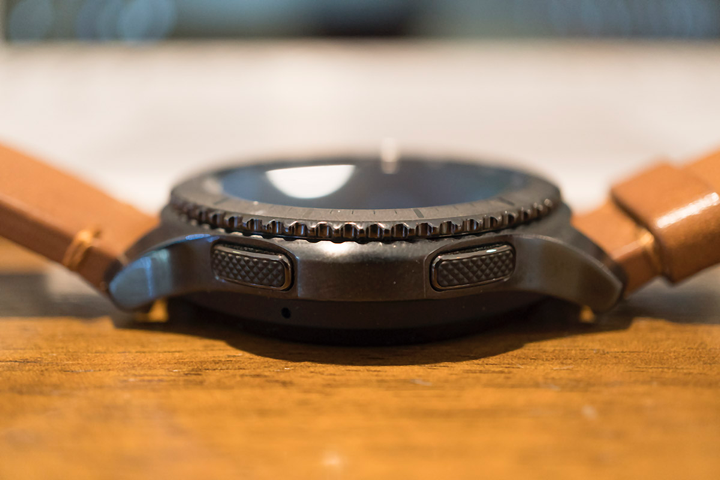
Quite fortunately, it did not take long for the manufacturers to learn about peculiarity of items to be worn on wrists. Admittedly, challenges from relatively shorter history of brands may still remain that these manufacturer started paving detours to find devices that would potentially be worn well on their customers’ wrists. Throughout their quest for finding answers, Samsung’s Gear S2 and S2 Classic can be deemed the first experiment in fusing elements of smart devices and conventional watches. In other words, these represent adaptability to changes in environment, and similarity to conventional watches. Most of all, its unique interface inspired from dial replaced conventional stems left impression that Samsung’s smart watch product marked itself a symbolic figure of a good combination in innovative elements of smart devices and conventional elements of watches.
Gear S2 has obviously been a product that took a leap from conventional wisdom surrounding smart devices and watches, yet there has still remained some unfamiliarity to consumers. The impression lingered on for Samsung’s smart watch that it was a defiant device, rather than a device harmonizing with fashion elements and cultural aspects surrounding watches. However, the market demanded smart watches that can be familiar and easy to use for customers, rather than experimental kinds that remain to distance themselves from the world of wrist watches. Hence the biggest challenge that Gear S3 faced was to find resolutions to look itself easier for larger number of its potential customers to use.
If that was part the intention, then Gear S3, offered with Frontier and Classic, has performed well. First introduced in the market in the fall of 2016, this smart watch was refurbished with its look closer to what can be related with watches, and is still available in the market (admittedly, when it comes to the vitality of Apple Watch in the market, it still sees some room for improvement). Given that Gear S2 survived in the market for the past two years with with its look and limited updates, it is indeed one of few cases to keep keen eyes on Samsung’s strategy surrounding products, as the smart device company lets go of products from its portfolio once it sees that the product its out of date.
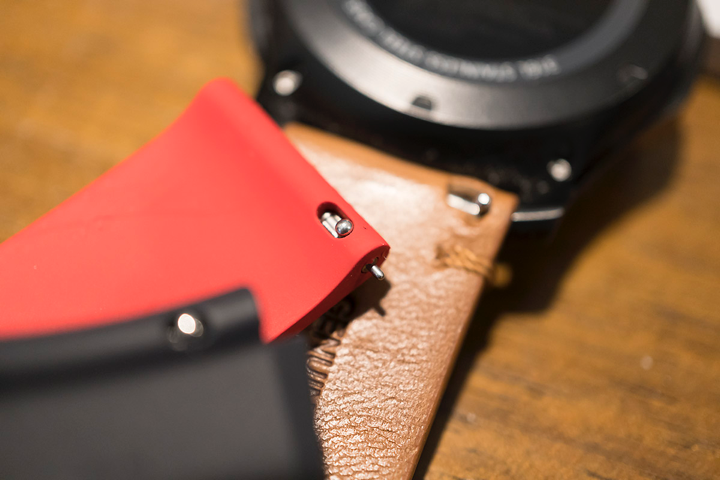
Ecology Of Gear To Fill Gaps In Stories
For Samsung, Gear S3 is a smart watch that still keeps creating its own story. When the announcement was first made on release of the product, the focus of storytelling was laid on hardware. Now, in contrast, the storytelling is pivoting around the environment surrounding use of Gear S3. Notably, only a handful of smart watches can share such lengthy stories like those of Samsung’s.
Admittedly, Gear S3 is on a similar extent to Gear S2 series, yet Frontier is building an entirely different image. Gear S2 has started constructing a relatively refined image because Gear S3 Frontier has been introduced with its boldness in design. The screen is only 0.1 inches larger than that of Gear S2, yet the circumference has become larger and thicker. Nevertheless, Gear S3 continues to look like a watch thanks to a very small modification – the time zone around the display panel. Without the time zone, Gear S3 would again probably have ended up with questions such as “what is that thing on your wrist?” Most of all, Gear S3 Frontier poses an image that it is an outdoor watch. With larger size, dark color, and saw toothed dial that tirelessly move around the watch, S3 Frontier leaves firmer and stronger impression than S3 Classic. It would perhaps be difficult to deny that S3 Frontier can be a better fit for active customers.
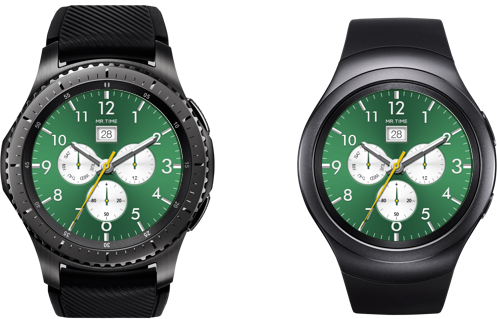
Gear S3 Frontier & Gear S2 Sport
MR.TIME DEMANTOID on devices
Compared to Gear S2, AMOLED display panel of Gear S3 measures 0.1inches larger, 1.3 inches, but in reality, the difference can be felt much larger. Similar to tablet PC products, smart watches can also give more clarity with larger screens, and Gear S3 offers such. If you become familiar to larger screens, you’d probably find yourself frustrated with smaller ones. But improvement on the resolution (360 x 360) has not been made proportionately to updates on size that some customers may find some room for improvement in details on letters or icons displayed. At first, the majority of customers may not notice them, but they are likely to find these catching their eyes.
With the strength in larger and clear display panel and sturdy look, S3 Frontier has continued to pave its path for improvement in environment that can make itself usable. Two years from the time when only a handful of explanation can be offered regarding limited applications and service, the lasted Gear series is more or less ready to offer applications that can match in virtually any kind of user environment. Whether you are being active, listening to music, looking at maps, going on fishing, or even playing golf, you would find little difficulties in finding useful applications to meet your purpose. Quite unlike Gear S2 that offered GPS as part of so-called formality, Gear S3 has become useful in most of outdoor activities.
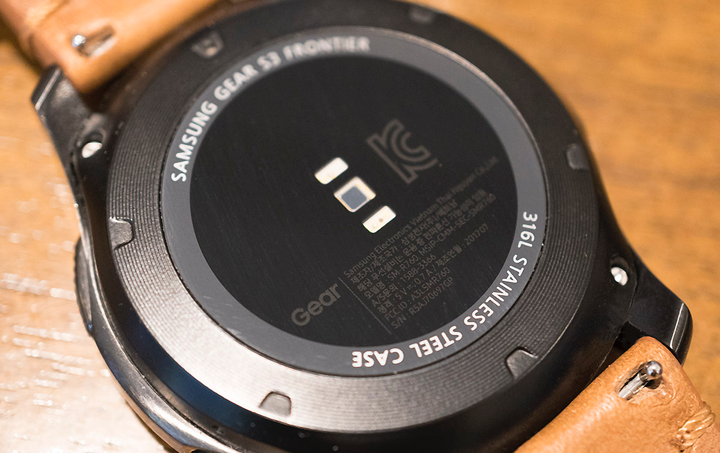
Yet quite interestingly, even if you don’t download any applications, you can still have Samsung’s latest smart watch remind you to stay active or nudge you into exercising when you spend too many minutes in front of your desk. You can just stand up and follow what your smart watch tell you to do, or have S Health keep track of your health record with heart rate sensor. You can even make your payment with Samsung Pay, pay public transportation fares, or manipulate Samsung home appliance products at home. Furthermore, you can entertain yourself with games. Most importantly, you can pair with most of Android and iPhone products, as well as Samsung smart phones.
You can choose your favorite watch faces from an endless list from the Gear Store. A vast variety of watch makers including MR.TIME are offering their items at the Store, that customers can no longer complain about limited number of face watches as the weakness of Samsung’s smart watches. Moreover, straps are much easier to change. With replacement of pins to enable most of straps measuring 32mm to be used, customers can easily switch their watch straps to match their style.
To make all of these possible, however, function and durability of battery will make up significant parts. Yet you don’t need to worry whether Gear S3 will last more than one day once it is fully charge, because even if you sometimes forget to recharge, you can find yourself being able to use until the next day, even when for instance, turn on power saving mode, opt to display some necessary information on the screen, or eve take off from your wrist. With water and dust proof level reaching IP68, I personally have had little impact from durability related issue even on rainy days or in wet environment. But every time I find some postings on online communities that read “my smart watch started malfunctioning after it was soaked,” I find myself being concerned.
Completion In Mechanical Finish, Compromise In Cultural Finish
Taking a closer look at this point, Gear S3 shares its stories that seemingly has no end. Two years ago from today. most of comments would have been made up of critique on features and environment that posed limitation for users before conclusion. Today, in contrast, the latest updates of Gear series filled the gap from weaknesses, and further, from lack of stories. In short, with user environment closer to perfection, improvement of quality of hardware has followed through.
Nevertheless, even with improvement in user environment of Gear S3, there are still a few items of concern. There are clearly a few issues that makes this latest update of Gear series less than perfect at this point. One of them is branding. As a brand that seeks to herald in watch industry, this is one of the key topics that Samsung needs to keep its eye on to ensure its competitiveness in the market.
Samsung has named its products Gear since it first started its endeavor in the smart watch market. However, the name dwells on the category of smart watch. Rather, Gear has evolved into a brand name for Samsung’s wearable devices. For the past two years, with expansion of usage of the brand name to a variety of wearable devices, Gear can no longer be considered signature brand name for smart watch categories.
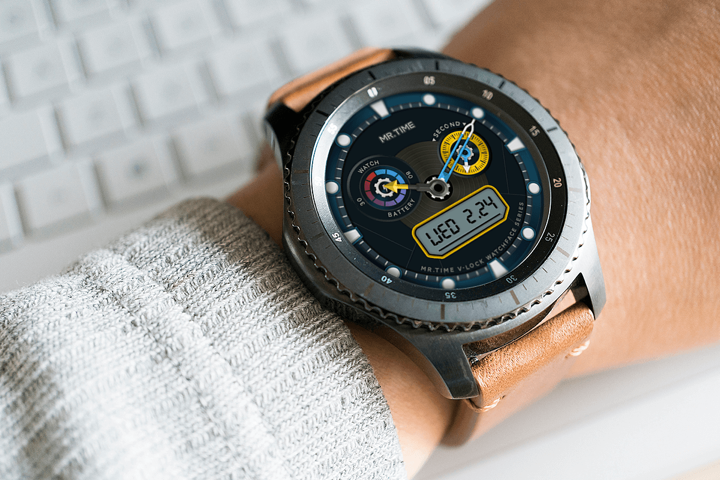
To this extent, the question can be casted as following – Gear S series is a series of powerful wearable devices, yet can it be perceived as a series of powerful digital watches? The subnames following the name Gear may indicate that the products are smart watches, but only to those familiar or knowledgeable about the category. This can be concluded that the smart device manufacturer has spent two years of time not observing that its Gear series had no subnams to hint that it offers smart watches.
It may occur to many that Samsung could have had enough time and opportunity to either streamline the naming to add softness and thus curb machine-like brand images, or fortify the brand image. If Samsung chose to tilt toward unveiling defying device, rather than fashion and culture infused device, then it would be understandable. Nevertheless, it is discouraging for many of the fans – whilst Gear S3 approached closer to perfection, there is little cultural elements that a smart watch brand should have secured. One of the most saddening part is that Samsung’s customers are likely to find limited cultural elements surrounding what they have on their wrists.



